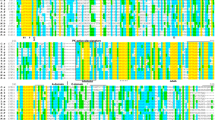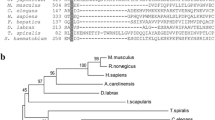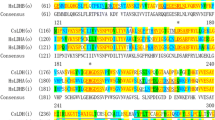Abstract
Globally, 15–20 million people are infected with Clonorchis sinensis (C. sinensis) which results in clonorchiasis. In China, clonorchiasis is considered to be one of the fastest-growing food-borne parasitic diseases. That more key molecules of C. sinensis are characterized will be helpful to understand biology and pathogenesis of the carcinogenic liver fluke. Glyceraldehyde-3-phosphate dehydrogenases (GAPDHs) from many species have functions other than their catalytic role in glycolysis. In the present study, we analyzed the sequence and structure of GAPDH from C. sinensis (CsGAPDH) by using bioinformatics tools and obtained its recombinant protein by prokaryotic expression system, to learn its expression profiles and molecular property. CsGAPDH could bind to human intrahepatic biliary epithelial cell in vivo and in vitro by the method of immunofluorescence assays. CsGAPDH also disturbed in lumen of biliary tract near to the parasite in the liver of infected rat. Western blotting analysis together with immunofluorescence assay indicated that CsGAPDH was a component of excretory/secretory proteins (CsESPs) and a surface-localized protein of C. sinensis. Quantitative real-time PCR (Q-PCR) and Western blotting demonstrated that CsGAPDHs are expressed at the life stages of adult worm, metacercaria, and egg, but the expression levels were different from each other. Recombinant CsGAPDH (rCsGAPDH) was confirmed to have the capacity to catalyze the conversion of glyceraldehyde 3-phosphate to D-glycerate 1,3-bisphosphate which was inhibited by AMP in a dose-dependent manner. In addition, rCsGAPDH was able to interact with human plasminogen in a dose-dependent manner by ELISA. The interaction could be inhibited by lysine. The plasminogen binding capacity of rCsGAPDH along with the distribution of CsGAPDH in vivo and in the liver of C. sinensis-infected rat hinted that surface-localized CsGAPDH might play an important role in host invasion of the worm besides its glycolytic activity. Our work will be a cornerstone for getting more messages about CsGAPDH and its role in biology and parasitism of C. sinensis.







Similar content being viewed by others
References
Alvarez RA, Blaylock MW, Baseman JB (2003) Surface localized glyceraldehyde-3-phosphate dehydrogenase of Mycoplasma genitalium binds mucin. Mol Microbiol 48(5):1417–1425
Bustin SA (2000) Absolute quantification of mRNA using real-time reverse transcription polymerase chain reaction assays. J Mol Endocrinol 25(2):169–193
Charrier-Ferrara S, Caillol D, Goudot-Crozel V (1992) Complete sequence of the Schistosoma mansoni glyceraldehyde-3-phosphate dehydrogenase gene encoding a major surface antigen. Mol Biochem Parasitol 56(2):339–343
Chen XQ, Li S, He L, Wang XY, Liang P, Chen WJ, Bian M, Ren MY, Lin JS, Liang C, Xu J, Wu ZD, Li XR, Huang Y, Yu XB (2013) Molecular characterization of severin from Clonorchis sinensis excretory/secretory products and its potential anti-apoptotic role in Hepatocarcinoma PLC cells. PLoS Neg Trop Dis 7(12):e2606
Erttmann KD, Kleensang A, Schneider E, Hammerschmidt S, Buttner DW, Gallin M (2005) Cloning, characterization and DNA immunization of an Onchocerca volvulus glyceraldehyde-3-phosphate dehydrogenase (Ov-GAPDH). Biochim Biophys Acta 1741(1–2):85–94
Ferreira E, Gimenez R, Aguilera L, Guzman K, Aguilar J, Badia J, Baldoma L (2013) Protein interaction studies point to new functions for Escherichia coli glyceraldehyde-3-phosphate dehydrogenase. Res Microbiol 164(2):145–154
Ganapathy-Kanniappan S, Kunjithapatham R, Geschwind JF (2012) Glyceraldehyde-3-phosphate dehydrogenase: a promising target for molecular therapy in hepatocellular carcinoma. Oncotarget 3(9):940–953
Goji N, Potter AA, Perez-Casal J (2004) Characterization of two proteins of Staphylococcus aureus isolated from bovine clinical mastitis with homology to glyceraldehyde-3-phosphate dehydrogenase. Vet Microbiol 99(3–4):269–279
Goudot-Crozel V, Caillol D, Djabali M, Dessein AJ (1989) The major parasite surface antigen associated with human resistance to schistosomiasis is a 37-kD glyceraldehyde-3P-dehydrogenase. J Exp Med 170(6):2065–2080
Gozalbo D, Gil-Navarro I, Azorin I, Renau-Piqueras J, Martinez JP, Gil ML (1998) The cell wall-associated glyceraldehyde-3-phosphate dehydrogenase of Candida albicans is also a fibronectin and laminin binding protein. Infect Immun 66(5):2052–2059
Han K, Xu L, Yan R, Song X, Li X (2012) Vaccination of goats with glyceraldehyde-3-phosphate dehydrogenase DNA vaccine induced partial protection against Haemonchus contortus. Vet Immunol Immunopathol 149(3–4):177–185
Hannibal L, Collins D, Brassard J, Chakravarti R, Vempati R, Dorlet P, Santolini J, Dawson JH, Stuehr DJ (2012) Heme binding properties of glyceraldehyde-3-phosphate dehydrogenase. Biochemistry 51(43):8514–8529
Hong ST, Fang YY (2012) Clonorchis sinensis and clonorchiasis, an update. Parasitol Int 61(1):17–24
Hu F, Yu X, Ma C, Zhou H, Zhou Z, Li Y, Lu F, Xu J, Wu Z, Hu X (2007) Clonorchis sinensis: expression, characterization, immunolocalization and serological reactivity of one excretory/secretory antigen-LPAP homologue. Exp Parasitol 117(2):157–164
Huang Y, Chen WJ, Wang XY, Liu HL, Chen YY, Guo L, Luo F, Sun JF, Mao Q, Liang P, Xie ZZ, Zhou CH, Tian YL, Lv XL, Huang LS, Zhou JJ, Hu Y, Li R, Zhang F, Lei HL, Li WF, Hu XC, Liang C, Xu J, Li XR, Yu XB (2013a) The carcinogenic liver fluke, Clonorchis sinensis: new assembly, reannotation and analysis of the genome and characterization of tissue transcriptomes. PLoS One 8(1):e54732
Huang Y, Liao H, Li W, Hu Y, Huang L, Wang X, Sun J, Chen W, Deng C, Liang C, Wu Z, Li X, Xu J, Yu X (2013b) Identification, sequence analysis and characterization of Clonorchis sinensis ubiquitin. Exp Parasitol 133(1):62–69
Jong AY, Chen SH, Stins MF, Kim KS, Tuan TL, Huang SH (2003) Binding of Candida albicans enolase to plasmin(ogen) results in enhanced invasion of human brain microvascular endothelial cells. J Med Microbiol 52(Pt 8):615–622
Kinoshita H, Uchida H, Kawai Y, Kawasaki T, Wakahara N, Matsuo H, Watanabe M, Kitazawa H, Ohnuma S, Miura K, Horii A, Saito T (2008) Cell surface Lactobacillus plantarum LA 318 glyceraldehyde-3-phosphate dehydrogenase (GAPDH) adheres to human colonic mucin. J Appl Microbiol 104(6):1667–1674
Lahteenmaki K, Edelman S, Korhonen TK (2005) Bacterial metastasis: the host plasminogen system in bacterial invasion. Trends Microbiol 13(2):79–85
Lama A, Kucknoor A, Mundodi V, Alderete JF (2009) Glyceraldehyde-3-phosphate dehydrogenase is a surface-associated, fibronectin-binding protein of Trichomonas vaginalis. Infect Immun 77(7):2703–2711
Liu F, Cui SJ, Hu W, Feng Z, Wang ZQ, Han ZG (2009) Excretory/secretory proteome of the adult developmental stage of human blood fluke, Schistosoma japonicum. Mol Cell Proteomics 8(6):1236–1251
Livak KJ, Schmittgen TD (2001) Analysis of relative gene expression data using real-time quantitative PCR and the 2(-Delta Delta C(T)) Method. Methods 25:402–408
Luo S, Hoffmann R, Skerka C, Zipfel PF (2013) Glycerol-3-phosphate dehydrogenase 2 is a novel factor H-, factor H-like protein 1-, and plasminogen-binding surface protein of Candida albicans. J Infect Dis 207(4):594–603
Matta SK, Agarwal S, Bhatnagar R (2010) Surface localized and extracellular Glyceraldehyde-3-phosphate dehydrogenase of Bacillus anthracis is a plasminogen binding protein. Biochim Biophys Acta 1804(11):2111–2120
Morphew RM, Wright HA, Lacourse EJ, Woods DJ, Brophy PM (2007) Comparative proteomics of excretory-secretory proteins released by the liver fluke Fasciola hepatica in sheep host bile and during in vitro culture ex host. Mol Cell Proteomics 6(6):963–972
Nicholls C, Pinto AR, Li H, Li L, Wang L, Simpson R, Liu JP (2012) Glyceraldehyde-3-phosphate dehydrogenase (GAPDH) induces cancer cell senescence by interacting with telomerase RNA component. Proc Natl Acad Sci 109(33):13308–13313
Pancholi V, Chhatwal GS (2003) Housekeeping enzymes as virulence factors for pathogens. Int J Med Microbiol 293(6):391–401
Petney TN, Andrews RH, Saijuntha W, Wenz-Mucke A, Sithithaworn P (2013) The zoonotic, fish-borne liver flukes Clonorchis sinensis, Opisthorchis felineus and Opisthorchis viverrini. Int J Parasitol 43(12–13):1031–1046
Qian M, Chen Y, Liang S, Yang G, Zhou X (2012) The global epidemiology of clonorchiasis and its relation with cholangiocarcinoma. Infect Dis Povert 1(1):4–15
Qian MB, Chen YD, Fang YY, Tan T, Zhu TJ, Zhou CH, Wang GF, Xu LQ, Zhou XN (2013) Epidemiological profile of Clonorchis sinensis infection in one community, Guangdong, People’s Republic of China. Parasit Vectors 6:194
Seidler NW (2013) GAPDH: biological properties and diversity. Adv Exp Med Biol 985
Sirover MA (2011) On the functional diversity of glyceraldehyde-3-phosphate dehydrogenase: biochemical mechanisms and regulatory control. Biochim Biophys Acta 1810(8):741–751
Tricarico C, Pinzani P, Bianchi S, Paglierani M, Distante V, Pazzagli M, Bustin SA, Orlando C (2002) Quantitative real-time reverse transcription polymerase chain reaction: normalization to rRNA or single housekeeping genes is inappropriate for human tissue biopsies. Anal Biochem 309(2):293–300
Wagener J, Schneider JJ, Baxmann S, Kalbacher H, Borelli C, Nuding S, Kuchler R, Wehkamp J, Kaeser MD, Mailander-Sanchez D, Braunsdorf C, Hube B, Schild L, Forssmann WG, Korting HC, Liepke C, Schaller M (2013) A peptide derived from the highly conserved protein GAPDH is involved in tissue protection by different antifungal strategies and epithelial immunomodulation. J Invest Dermatol 133(1):144–153
Wang X, Chen W, Hu F, Deng C, Zhou C, Lv X, Fan Y, Men J, Huang Y, Sun J, Hu D, Chen J, Yang Y, Liang C, Zheng H, Hu X, Xu J, Wu Z, Yu X (2011a) Clonorchis sinensis enolase: identification and biochemical characterization of a glycolytic enzyme from excretory/secretory products. Mol Biochem Parasitol 177(2):135–142
Wang XY, Chen WJ, Huang Y, Sun JF, Men JT, Liu HL, Luo F, Guo L, Lv XL, Deng CH, Zhou CH, Fan YX, Li XR, Huang LS, Hu Y, Liang C, Hu XC, Xu J, Yu XB (2011b) The draft genome of the carcinogenic human liver fluke Clonorchis sinensis. Genome Biol 12(10):R107
Wang C, Han C, Li T, Yang D, Shen X, Fan Y, Xu Y, Zheng W, Fei C, Zhang L, Xue F (2013) Nuclear translocation and accumulation of glyceraldehyde-3-phosphate dehydrogenase involved in diclazuril-induced apoptosis in Eimeria tenella (E. tenella). Vet Res 44:29
Winram SB, Richardson LC, Lottenberg R (1995) Mutational analysis of a plasmin receptor protein expressed by group A streptococci. Dev Biol Stand 85:199–202
Wizemann H, von Brunn A (1999) Purification of E. coli-expressed HIS-tagged hepatitis B core antigen by Ni2+−chelate affinity chromatography. J Virol Methods 77(2):189–197
Yao LL, Wang YG, Liu XJ, Zhou Y, Li N, Liu J, Zhu YC (2012) Phenylephrine protects cardiomyocytes from starvation-induced apoptosis by increasing glyceraldehyde-3-phosphate dehydrogenase (GAPDH) activity. J Cell Physiol 227(10):3518–3527
Yoo WG, Kim TI, Li S, Kwon OS, Cho PY, Kim TS, Kim K, Hong SJ (2009) Reference genes for quantitative analysis on Clonorchis sinensis gene expression by real-time PCR. Parasitol Res 104(2):321–328
Zhang J, Snyder SH (1992) Nitric oxide stimulates auto-ADP-ribosylation of glyceraldehyde-3-phosphate dehydrogenase. Proc Natl Acad Sci 89(20):9382–9385
Zhang YL, Wu D, Yu XB (2005) Purification, enzyme activity and immunology study of recombinant protein glyceraldehyde-3-phosphate dehydrogenase of Clonorchis sinensis. Zhongguo Ji Sheng Chong Xue Yu Ji Sheng Chong Bing Za Zhi 23(4):231–235 [Article in Chinese]
Acknowledgments
This work was supported by the National Natural Science Foundation of China (No. 81101270), the National Key Basic Research and Development Project (973 project, No. 2010CB530000), and the National Important Sci-Tech Special Projects (2012ZX10004220).
Author information
Authors and Affiliations
Corresponding author
Electronic supplementary material
Below is the link to the electronic supplementary material.
Fig. S1
Amino acid sequence alignment of CsGAPDH with GAPDHs from other species. Amino acid sequence of GAPDH from C. sinensis (Cs, GenBank Accession No.: GAA28380.1), H. sapiens (Hs, GenBank Accession No.: AAH83511.1), R. norvegicus (Rn, GenBank Accession No.: NP_058704.1), M. musculus (Mm, GenBank Accession No.: NP_032110.1), C. elegans (Ce, GenBank Accession No.: CAA28504.1), P. falciparum (Pf, GenBank Accession No.: AAD10249.1) and S. japonicum (Sj, GenBank Accession No.: CAX80263.1) were included in the analysis. Identical amino acids in all sequences were marked with bright yellow background. Identical amino acids in most sequences were showed bright blue background. The NAD (P)-binding domain of GAPDH N-terminus (aa5–152) was illustrated in the rose-red rectangles. The asterisks (*) indicated the active site (aa150–157, ASCTTNCL). The catalytic domain of GAPDH C-terminus (aa157–314) was showed by rose-red underline. (GIF 458 kb)
Fig. S2
Inhibition effect of AMP on the enzymatic activity. The enzymatic activity was inhibited by AMP in a dose-dependent manner. AMP caused nearly to 70 % inhibition at 4 mM. The symbols represented mean±S.D of an experiment done in triplicates. (GIF 5 kb)
Rights and permissions
About this article
Cite this article
Hu, Y., Zhang, E., Huang, L. et al. Expression profiles of glyceraldehyde-3-phosphate dehydrogenase from Clonorchis sinensis: a glycolytic enzyme with plasminogen binding capacity. Parasitol Res 113, 4543–4553 (2014). https://doi.org/10.1007/s00436-014-4144-x
Received:
Accepted:
Published:
Issue Date:
DOI: https://doi.org/10.1007/s00436-014-4144-x




